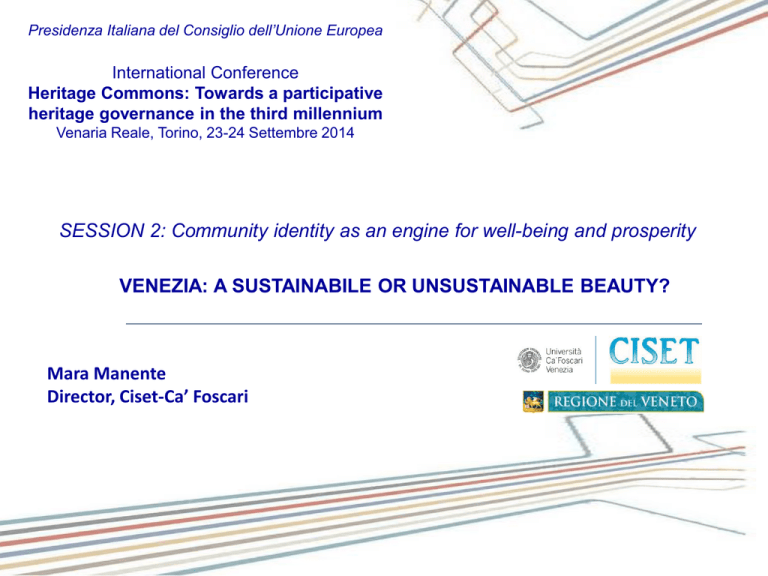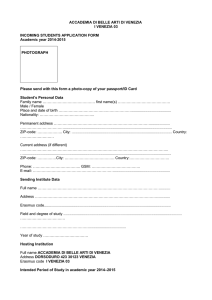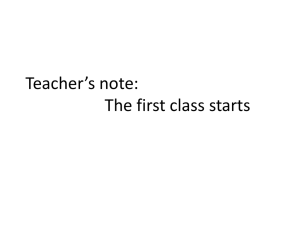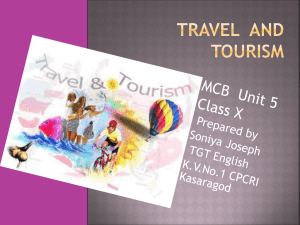VENEZIA - Università Ca
advertisement

Presidenza Italiana del Consiglio dell’Unione Europea International Conference Heritage Commons: Towards a participative heritage governance in the third millennium Venaria Reale, Torino, 23-24 Settembre 2014 SESSION 2: Community identity as an engine for well-being and prosperity VENEZIA: A SUSTAINABILE OR UNSUSTAINABLE BEAUTY? Mara Manente Director, Ciset-Ca’ Foscari VENEZIA: A SUSTAINABILE OR UNSUSTAINABLE BEAUTY? A BIG “ATTRACTION” - Historical Centre: About 2.5 mln total arrivals (+1.9%) and 6.2 mln total nights (+2.9%) in 2013 - International Tourists: 2,2 mln arrivals and 5,5 mln nights (88% of the total) - Residents in the Historical Centre: 58.700 - turists/residents ratio: about 42 overnighting tourists 2800000 2600000 2400000 2200000 2000000 1800000 1600000 1400000 1200000 1000000 800000 600000 400000 200000 Source: Comune di Venezia 2012 2009 2006 2003 2000 1997 1994 1991 1988 1985 1982 1979 1976 1973 1970 1967 1964 1961 1958 1955 1952 0 1949 Venezia Historical Centre: tourist arrivals trend …. and the bed places …… Venezia HC: Total bedplaces trend 30000 28000 26000 24000 22000 20000 18000 16000 14000 12582 12000 10000 8000 6000 4000 2000 0 1995 26273 59,5% 40,5% 2011 61,0% 39,0% 2010 61,9% 38,1% 2005 72,4% 2000 14470 2000 1995 20% 40% Alberghi Alberghieri 2010 2011 2012 Extralberghieri 17,3% 87,5% 0% 2005 Venezia HC: bedplaces composition (% values). 1995-2012 27,6% 82,7% 27763 19670 Totali 2012 26600 12,5% 60% Extralb. 80% 100% Fonte: Elaborazioni CISET su dati Comune di Venezia VENEZIA - TOTAL VISITORS: the numbers are higher than official statistics About 20 mln visitors per year (358 visitors/residents ratio) of which: Excursionists (70%) Cruisers False excursionists Other excursionists Tourists (30%) C r u i s e r s TOTAL GROSS REVENUE : 1,5-2 bln euros Other tourists DIFFERENT TYPOLOGIES OF VISITORS Very high weight of same-day visitors in comparison to tourists (about 70:30) FALSE EXCURSIONISTS – - visitors who choose to stay outside the Historical Centre even though Venezia is their main travel destination VENICE RELEVANT TOURIST REGION the area where false excursionists stay, outside the historical centre OTHER EXCURSIONISTS • true excursionists – visitors coming from and going back to their place of residence in the same day • indirect excursionists - visitors coming from and going back to the place where they are spending their holidays during the same day • in-transit excursionists – visitors making a stop during their travel from home to another destination or during a travel itinerary EXCURSIONISTS bring the destination more costs and less benefits than traditional tourist as the main share of their budget (accommodation) is non-existent or benefits other areas • COSTS MOSTLY TO THE DESTINATION • BENEFITS MOSTLY OUTSIDE IT VENEZIA AND ITS RELEVANT TOURIST REGION MOBILITY AXES 45 MINUTES 45 MINUTES NOVENTA 45 MINUTES Terraglio SCORZE’ Piave JESOLO Mirano area MESTRE STRA’ Coastal axis Riviera Coastal axis Terme euganee MONSELICE 45 MINUTES SOTTOMARINA 45 MINUTES Source: CISET VENEZIA VS VENETO REGION Have you ever heard of the Veneto Region before? No 89,6% Have you ever visited this region? No, 85,1% BUT Have you visited Venice before? Yes, 83,6% Which sights would you like to visit/have you visited in Venice? •St Mark’s: yes 80,6% •Doge’s Palace: yes 76,1% •Peggy Guggenheim Collection: yes 41,8% •Scuola di San Rocco: yes 38,8% •Arsenal: yes 31,3% •Ca’ Rezzonico: yes 23,9% THE COSTS/BENEFITS BALANCE MASS TOURISM • • NEGATIVE EXTERNALITIES • • • • • • • pollution of the environment, due to ships, congestion, etc. crowding out of other urban functions, and a more complex “second level” crowding out, when activities related to cultural, high-quality visits are replaced with others selling cheap, mass flow oriented goods increase in the prices of any kind of good, affecting residents’ welfare congestion, worsened by seasonality parking problems contests on the use of spaces for different purposes Clash between residents and visitors • Visitors pay for the “support services“ provided by commercial activities The costs for the provision of the primary attractions lie mainly on the residents The fiscal mechanism cannot completely bridge the gap !!!! The problem of costs/benefits balance can be further complicated by the visitors composition (tourists/excursionists ratio) VENEZIA PROFILE • Venezia is a complex destination, with strong relationships with the mainland and the surrounding tourist region • Excursionist flows in the historical centre are a strong component of total tourist demand, with a higher weight than in other national and European art cities (e.g. Rome, Paris) • There is a high percentage of first time visitors vs. repeaters. Of those who return for different reasons (special events, etc.) only 12% stay in the historical centre; 37% choose an accommodation in the mainland and 31% in the relevant tourist region (Source:CISET) • The crowding out of other urban economic functions and of activities related to high-quality visits is still evident, in spite of recent evolution of cultural supply (new attractions and events) • According to the current competitive environment, the sustainability and competitiveness of the destination stay in its capacity to attract new market segments, to increase the significance of core attractions and make tourism a component of a complex project of urban development The risks The Product Vagueness of the atmosphere Very traditional elements and poor innovation High risk of standardising and banalising Markets High % of visitors at their first experience (70% vs 50% in other art cities) Low differentiation in motivations (against high differentiation by origin market with increasing role of extra-Europe) Request for a standardised product High turnover of the clientele High dependence from poor differentiated markets Can we analize the competitive profile of Venezia? more than 90 variables Summary index Role of International tourism demand Variety of socio-demographic segments Calculation foreign arrivals / total arrivals (hard data) Weighted mean of scores given to the weight (number and intensity) of each socio-demographic segments on both domestic and international markets (surveys+experts) Variety of tourist activities/experiences Weighted mean of scores given to the weight (number and intensity) of each specific activity/experience performed by offered to tourists both domestic and international tourists (surveys+experts) Significance of core resources and attractors Competitiveness of accommodation supply Relative cost of the city for tourists Simple mean of scores given to the significance (variety and resonance) of different kinds of resources/attractors (surveys+experts) Simple mean of scores given to the capacity of accommodation supply to satisfy each expenditure profile (surveys+experts) Score obtained by comparing the scores given by experts to the perceived cost of the city for tourists and for residents Presence of the city Simple mean derived from the scores to the role the city had in the last 30 years in different fields(e.g. culture, style, etc.) Pulse of the city Simple mean derived from the scores given to vivacity of city life both at daytime and at night Simple mean of the scores given to the role each city is expected to have in different fields (culture, lifestyle, etc.) and to the economic and educational opportunities it offers/will offer Potential of the city economic role political role urban environment and services (transports, traffic jam...) tourists’ profiles and experience core resources and attractors accommodation prices (tourist prices, cost of living) branding (presence, pulse, attributes) Internet accessibility An “icon” city GENERAL BRAND INDICES •Tourism plays a driver role:: mono-culture •The city is the attraction: just a few sites are recognized, but the potential of the resources is not completely exploited •Reduced differentiation of tourism demand by motivation •No peculiar development or change to lead them out of their side-line role in the next 20 years • Powerful tourist brands, strongly attracting international demand, • Presence in other sectors (politics, economics, culture, fashion, etc. ) considered not so significant in the last 30 years • Urban life perceived as ‘static’ and not exciting (pulse)* * The two super-index have been conceived to be assimilable to Anholt City Brand Index order to compare resuls in PRIORITIES (1) According to the current competitive environment, the sustainability and competitiveness of the destination stay in its capacity to attract new market segments, to increase the significance of core attractions and make tourism a component of a complex project of urban development Reinforce and differentiate the economic base (avoid tourism as mono-colture) Increase the ratio of repeaters Differentiate motivations Qualify demand and its behaviour in order to avoid standardisation/banalisation …… priorities (2) re-qualify the “destination offer” within the context of the “Città Metropolitana” diversification of the offer : -following the “experience approach” to cultural products, - through the rediscover of the multi-faceted connections with the lagoon and the “terraferma” along the exiting mobility axes in order to avoid the “Gran Canal view” approach Many Thanks! Mara Manente CISET - Università Ca’ Foscari email: mara.manente03@unive.it ciset@unive.it URL: http//:www.unive.it/ciset @ilCISET @ manente03





